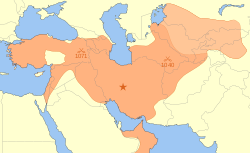Remove ads
সেলজুক (বা মহান সেলজুক সাম্রাজ্য[১০] অথবা সেল্ডজুক কখনো সেলজুক তুর্ক; তুর্কী ভাষায়: Selçuklular; ফার্সি ভাষায়: سلجوقيان সেলজুকাইন; আরবি ভাষায়: سلجوق সালজুক বা السلاجقة আল-সালাজিকা) সুন্নী মুসলমান সাম্রাজ্য যারা ১০ শতক থেকে ১৪ শতক পর্যন্ত মধ্য এশিয়া এবং মধ্য প্রাচ্য শাসন করেছেন। এই মহান সাম্রাজ্যের স্থপতি সুলতান তুঘরিল বেগ । চাগরি বেগ ছিলেন তুঘরিল বেগ এর বড় ভাই। তিনি জাতিতে অঘুজ তুর্কি ছিলেন।[১১] সুলতান মালিক বেগ এর শাসনকালে এই সাম্রাজ্য অর্ধ-পৃথিবী পর্যন্ত বিস্তৃত ছিলো। এর পরবর্তীতে এই সাম্রাজ্য ভেঙ্গে ছোট ছোট আমিরাতে পরিণত হয়। এবং পরবর্তীতে মঙ্গোল সাম্রাজ্য এই সাম্রাজ্যের উত্তরসূরি।
সেলজুক সাম্রাজ্য | |||||||||||||||||||||||||||||||||||||
|---|---|---|---|---|---|---|---|---|---|---|---|---|---|---|---|---|---|---|---|---|---|---|---|---|---|---|---|---|---|---|---|---|---|---|---|---|---|
| ১০৩৭–১১৯৪ | |||||||||||||||||||||||||||||||||||||
 মালিক শাহর মৃত্যুর সময় (১০৯২ সাল) সেলযুক সাম্রাজ্য | |||||||||||||||||||||||||||||||||||||
| অবস্থা | সাম্রাজ্য | ||||||||||||||||||||||||||||||||||||
| রাজধানী | নিশাপুর (১০৩৭–১০৪৩) রে (ইরাক) (১০৪৩–১০৫১) এসফাহন (১০৫১–১১১৮) হামাদান, পশ্চিম প্রান্তের রাজধানী (১১১৮–১১৯৪) মার্ভ, পূর্ব প্রান্তের রাজধানী (১১১৮–১১৫৩) | ||||||||||||||||||||||||||||||||||||
| প্রচলিত ভাষা | |||||||||||||||||||||||||||||||||||||
| সরকার | রাজতন্ত্র | ||||||||||||||||||||||||||||||||||||
| সুলতান | |||||||||||||||||||||||||||||||||||||
• ১০৩৭–১০৬৩ | তুঘরিল বেগ (প্রথম) | ||||||||||||||||||||||||||||||||||||
• ১১৭৪–১১৯৪ | তুঘরিল তৃতীয় (শেষ)[৫][৬] | ||||||||||||||||||||||||||||||||||||
| ইতিহাস | |||||||||||||||||||||||||||||||||||||
• তুঘরিল বেগ প্রতিষ্ঠা করেন | ১০৩৭ | ||||||||||||||||||||||||||||||||||||
| ১১৯৪ | |||||||||||||||||||||||||||||||||||||
| আয়তন | |||||||||||||||||||||||||||||||||||||
| আনু. ১০৮০[৮][৯] | ৩৯,০০,০০০ বর্গকিলোমিটার (১৫,০০,০০০ বর্গমাইল) | ||||||||||||||||||||||||||||||||||||
| |||||||||||||||||||||||||||||||||||||
| বর্তমানে যার অংশ | বর্তমান দেশসমূহ | ||||||||||||||||||||||||||||||||||||
Remove ads
সেলজুক সাম্রাজ্য (মূল)
- সেলজুক গাজী
- মিকাইল বেগ
- সুলতান তুঘরিল বেগ (১০৩৭ - ১০৬৩)
- আল্প আরসালান (১০৬৩ - ১০৭২) মৃত্যু - ১০৭২ জন্ম- ১০৩০
- প্রথম মালিক শাহ(১০৭২ - ১০৯২/৯৫)
- সুলতান প্রথম মাহমুদ (১০৯৫) জন্ম-মৃত্যু (১০৯১-১০৯৬)
- সুলতান বার্কিয়ারুক (১০৯৬-১১০৫) জন্ম-মৃত্যু (১০৮০ - ১১০৫)
- দ্বিতীয় মালিক শাহ্ (১১০৫)
- মুহাম্মদ তপার (১১০৫-১১১৮)
- দ্বিতীয় মাহমুদ (১১১৮)
- সুলতান আহমাদ সানজার (১১১৮ - ১১৫৩/৫৭)
সেলজুক সাম্রাজ্য (রোম) সুলতানদের রাজত্বকাল
- কুতলামিশ কুতুলমিশ (১০৬৩-১০৭৪)
- প্রথম সুলাইমান ১ম বার (১০৭৫-১০৭৭) ২য় বার (১০৭৭-১০৮৬)
- প্রথম ফিলিচ আরসালান (১০৯২-১১০৭)
- মালিক শাহ্ (১১০৭-১১১৬)
- প্রথম মাসউদ (১১১৬-১১৫৬/৫৭)
- দ্বিতীয় কিলিচ আরসালান (১১৫৭-১১৯২)
- প্রথম কায়খসরু বা ইজ্ আদ্-দ্বীন কায়খসরু ১ম বার (১১৯২-১১৯৬) ২য় বার (১২০৫ - ১২১১)
- দ্বিতীয় সুলাইমান (১১৯৬ - ১২০৪)
- তৃতীয় কিলিচ আরসালান (১২০৪ -১২০৫)
- প্রথম কায়কাউস (১২১১-১২১৯/২০)
- প্রথম কায়কোবাদ বা আলাউদ্দিন কায়কোবাদ দ্য গ্রেট কায়কোবাদ (১২২০- ১২৩৭)
- দ্বিতীয় কায়খসরু বা গিয়াসউদ্দিন কায়খসরু (১২৩৭-১২৪৬)
- দ্বিতীয় কায়কাউস বা ইজ আদ্-দ্বীন কায়কাউস (১২৪৬-১২৬২)
- দ্বিতীয় কায়কোবাদ আলাউদ্দিন (১২৪৯-১২৫৪) মৃত্যু - ১২৭৯
- চতুর্থ কিলিচ আরসালান বা রুকুনউদ্দিন আরসালান ১ম বার (১২৪৯-১২৫৪) ২য় বার (১২৫৭-১২৬৫)
- তৃতীয় কায়খসরু বা আলাউদ্দিন (১২৬৫ - ১২৮৪) ফাঁসি ১২৮৪
- দ্বিতীয় মাসউদ বা গিয়াস উদ্দিন মাসউদ বিন কায়কাউস > ১ম বার (১২৮২ - ১২৮৪) ⇒২য় বার (১২৮৪-১২৯৩) - ৩য় বার (১২৯৪-১৩০১) - ৪র্থ বার (১৩০৩ - ১৩০৭) নিহত ১৩০৮
- তৃতীয় কায়কোবাদ / আলাউদ্দিন (১২৯৮ - ১৩০২)
- তৃতীয় মাসউদ (১৩০৮ - ১৩০৮) - নিহত ১৩০৮
Remove ads
Wikiwand in your browser!
Seamless Wikipedia browsing. On steroids.
Every time you click a link to Wikipedia, Wiktionary or Wikiquote in your browser's search results, it will show the modern Wikiwand interface.
Wikiwand extension is a five stars, simple, with minimum permission required to keep your browsing private, safe and transparent.
Remove ads